
“The Shadow” 1953
oil and charcoal painting
51 x 38 inches
The departure of a lovely woman,
a child’s toy, sadness.

“The Suppliant” 1937
gouache painting, 9 x 7 inches
Graphic strength and the fearful wisdom of Guernica. Full angst.

“The Kiss” 1925
oil painting
51 x 38 inches
Full-on sensual and sexual energy together with threatening, playful elements.
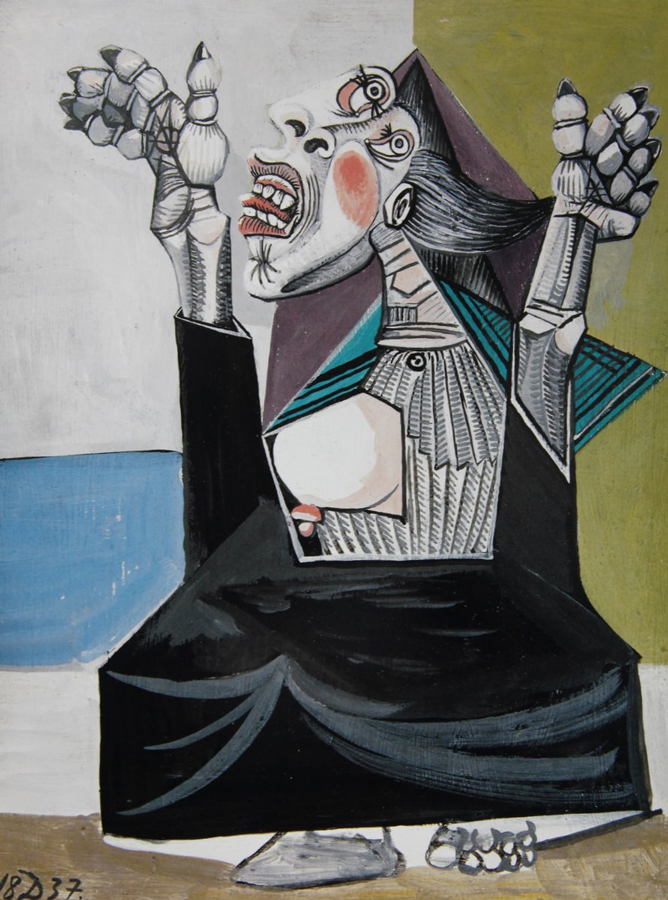
“Celestina (The Woman with one Eye)”
1904 oil painting
29 x 23 inches
An early, sensitive portrait. Already, damaged condition attracts.
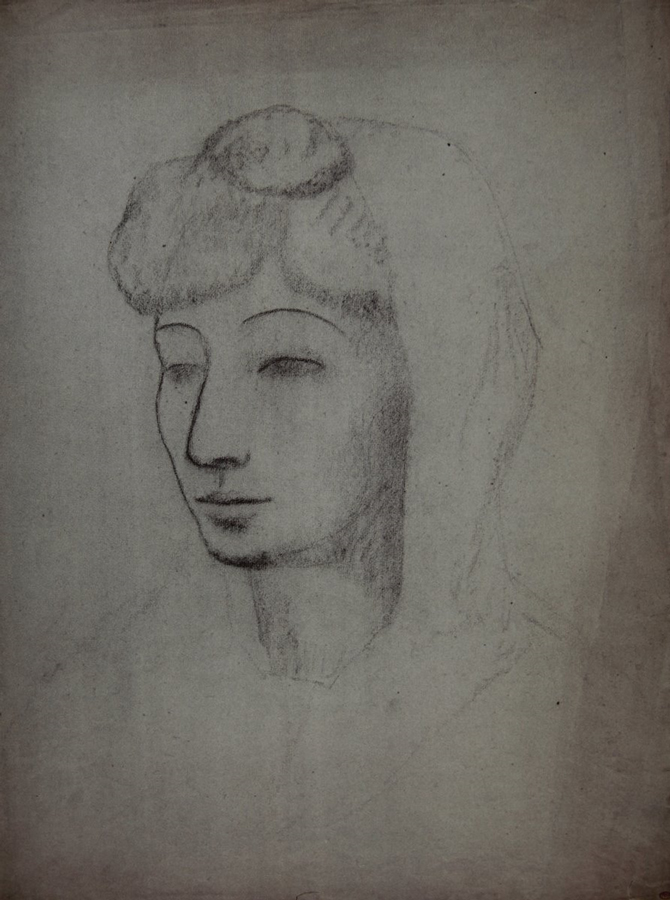
“Fernande in a White Mantilla” 1906
charcoal on paper
24 x 18 inches
Tentative and sparse. A man finding his way.
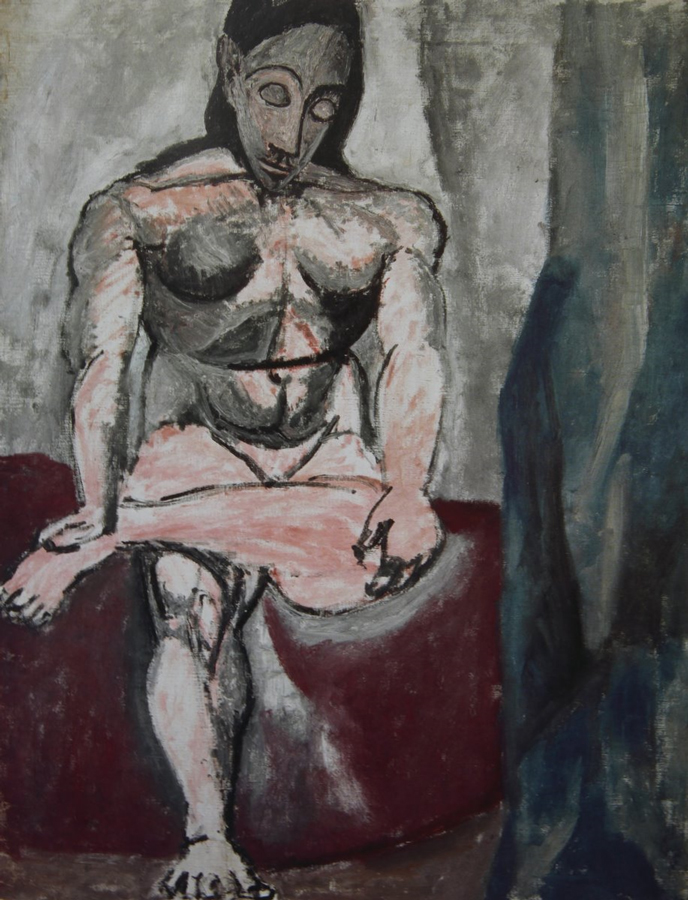
“Seated nude, study”
1906 oil painting
48 x 37 inches
Rough and energetic, we see the face/mask of the artist himself.
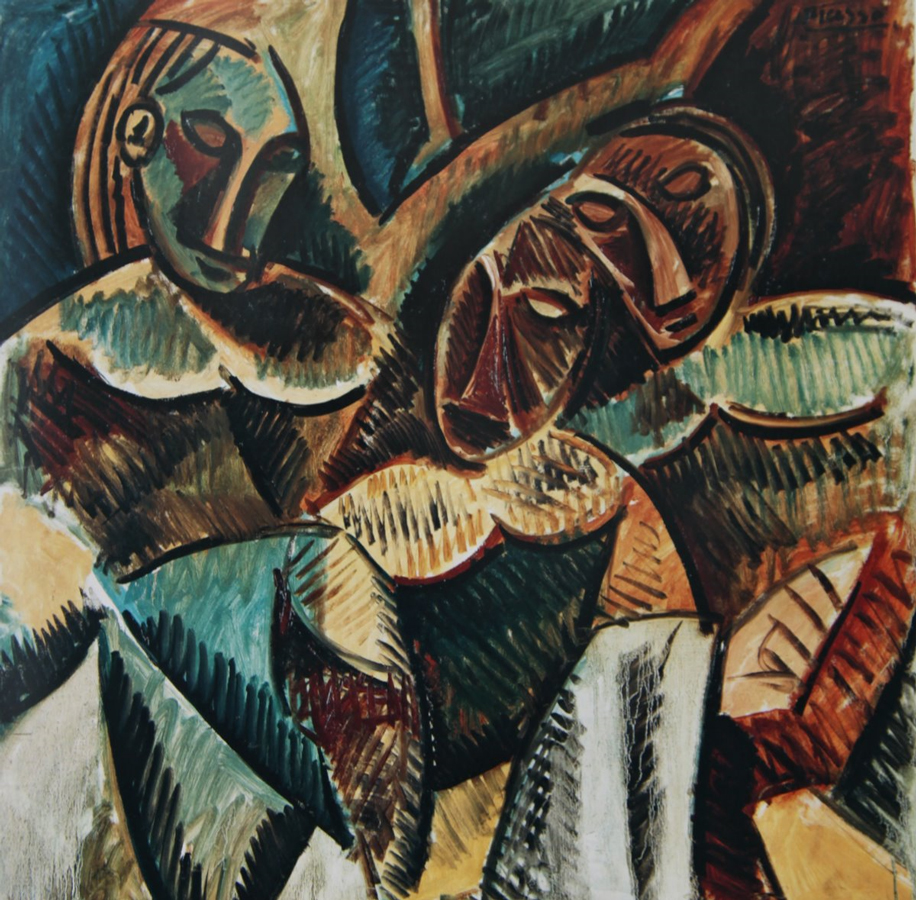
“Three Figures beneath a Tree”
1907 oil painting
39 x 39 inches
The African mask cajoled into an interactive pattern.
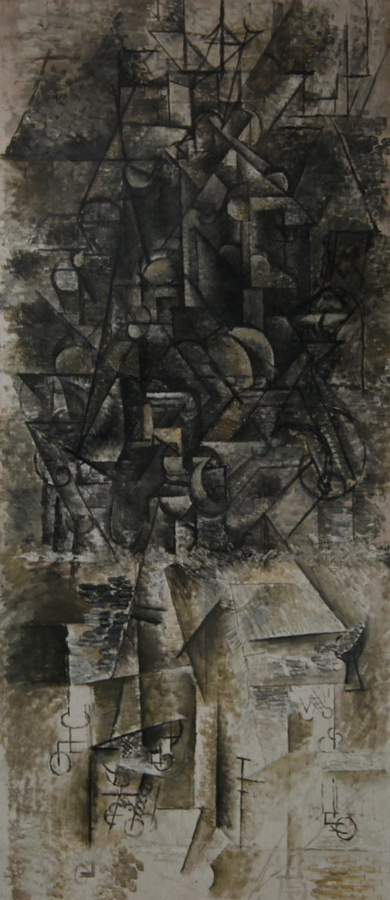
“Man with a Mandolin”
1911 oil painting
64 x 28 inches
Pure cubist extraction and we get to look for the mandolin.

“The Bathers”
1918 oil painting
11 x 9 inches
Delicate, caring, attentive rendering. I used to think this was a big one.
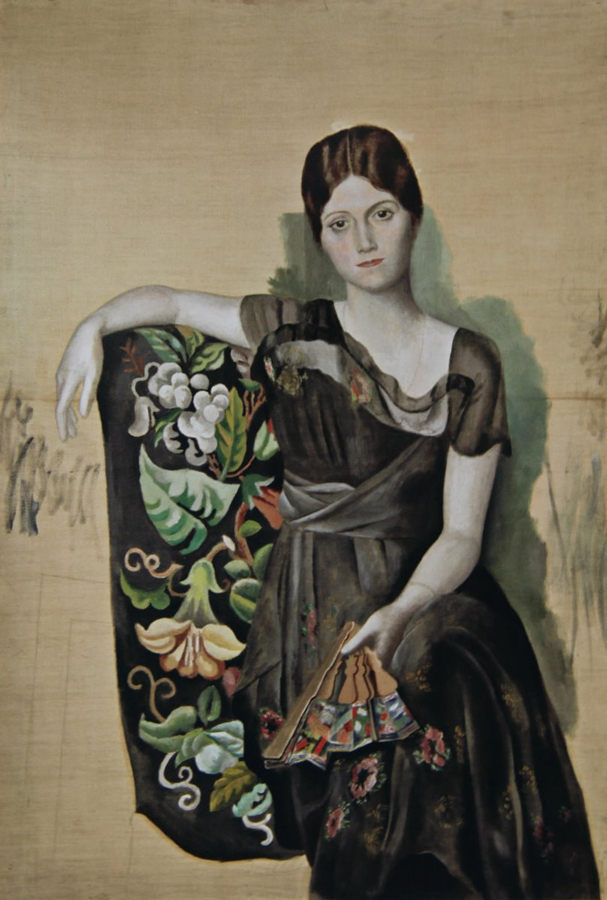
“Olga in an Armchair”
1918 oil painting, 51 x 35 inches
Done from a photo (also in the show) Classic, sensitive and tight.

“Paulo as Harlequin”
1924 oil painting, 51 x 38 inches
Their child as clown; nevertheless a sensitive and placid expression.
Archived Comments
Enjoy the past comments below for The ultimate curiosity…
Ah, Picasso. Some people “get” him, many hate him, and quite a few walk away in bewilderment. Indeed, his work must be experienced first hand and not be judged by an art book.
I dearly love his early works. There is a profound sensitivity in his portraits I find humbling. Those are what I personally study and respond to. With great command of style at such an early age abstraction seems a progressive step this artist would have taken. I study those later compositions because they are so complex. Picasso understood marketing like no other. He was as much a P. T. Barnum showman as an artist. He exploited every conceivable idea related to him. He understood persona, shock value, and the eliteness of the art market. The thing that annoys me about Picasso is art never knew when he was pulling their leg or not. He would just as soon do a caricature for fun as an abstraction and let us figure out which was the serious work. And many we still don’t know. The one that makes me cringe in acknowledgement of his genius is Guernica. Such a powerful rendition of the horror of war could never have been presented in any other style.If you can’t have a ball point pen, how are you going to stop a terrorist? A golf pencil won’t work. Here is how to run a modern museum: Turn down the lights so no one can see the work, plug everyone into audio zombies (words win, art loses), empower guards to ruin your experience, etc. What next? Full body scanners?
Be truthful Robert, Picasso’s work is so bad, so amateur. In the big picture he will be known as a “personality.” Unfortunately, many imitated him along the way in the hopes that they too could become rich and famous. Some did.
There are those who “lunch” at these museum events. Picasso called them “idlers.”
Picasso was no doubt a prolific painter and many considered him a genius and a giant in the art world. Perhaps his work is a parody of those people mostly his lady friends he painted. I think that those paintings of his wives and mistresses are very disrespectful to his subjects .If his works are biographical it is a form degradation to women. Perhaps it was the norm of those times, he portrayed himself as the ultimate “macho ” man who has the license to disrespect people. Give me an artist who is mindful of the dignity of his subjects to portray them as they really are truthfully not mock them.That is indeed a true genius in art.
I think one thing we can learn from senor Picasso, is do it your way. He did it his way, monochrome paintings, views from all angles, sticking pieces of paper and cardboard to canvas, as he said “all the bizarre things in my head”. Strange indeed for the time, but now pretty commonplace. But he did it his way and people have flocked to see his work. Now, maybe if you build it they will come, but it’s no guarantee, do it your way and maybe your work might wind up in the local thrift store but by stepping away from the conventional crowd and “doing it your way” I think you have a better chance of being appreciated as a creative artist, as opposed to just another “kittens in a basket” type painter.
And if you ever get the chance, watch the movie, “Surviving Picasso” with Anthony Hopkins. Picasso may of been one of the greatest artists of the 20th century but his personality sure needed work.Picasso was Picasso, nothing more-nothing less. Everyone knows his little “cinematic”story, but that is not nearly impressive as the way he marketed his art… that was impressive.
The hype around Picasso was eventually greater than his ability, as great as that was. This sort of thing is (and has been for a long time) most obvious in the “pop” culture, and, thankfully, most transient. But it still occurs in the art world as well. The darlings of a decade, are all but forgotten in another. Some fans and collectors like to think of their languishing favorites as “neglected,” but that’s not it at all. Previous media faves David Salle and Robert Longo are now name unknown to art students, even those who hunker down in the library with Art News and the like. They haven’t disappeared, and they still produce and command interesting prices, but they’ve peaked. Picasso seems not to have peaked in his lifetime– but he know exactly what was going on. Take a look at the phenomenon of the British artist Banksy for overt (and unsubtle) PR manipulation. In my opinion it’s vastly more skillful and interesting than the marks he makes. Julian Schnabel built a lauded career on paintings that, in my opinion, will eventually grace unfinished basements. Then, poof! He’s gone (or neglected, depending on your point of view) — except in Schnabels case, and fortunately for the audiences of cultural output, he tends to be a better film maker. Yeah, yeah, I know there’s a lot of taste involved, but once you get the media cooking and the “adventurous” (profligate?) collectors (like Saatchi) messing with the stew, it’s sometimes difficult to know the difference between being good and being famous. (For which we all need to have some trust in our internal compasses.) I don’t even want to talk about Damien Hirst or Tracey Emin.
I agree with Jackie Knott’s comment (above) about Guernica, by the way. Even if he had never painted anything else….
You didn’t mention a corresponding exhibit of Picasso prints at Davidson Galleries in downtown Seattle. A stunning display of his dead-on extemporaneous line expression!
It would’ve been cool to see you amongst the Picassos at SAM Picasso’s comment on art and entertainment was most fascinating. In the music industry the use of shock has been helpful to pop stars’ publicity and bank accounts. Dresses made of Meat! Ice cream cone shaped brassieres! Naked photos of John and Yoko! When does the line between artist and clown get crossed and does it matter? Or is the genius just being a genius and not consciously being sensationalist?
Your wonderful description of the Picasso event was only surpassed by what Picasso said of himself! The oysters sounded good too!
I’m glad that Picasso, for whatever reason, pushed the limits. He expanded the vision of what a painting could be.
I just thought this was a brilliant piece of writing today. You are always good, but today you were exceptional. Thank you for giving voice to our little niche in this world.
I visited the Picasso Museum in Paris and my favorite was a sculpture of a goat.
I read, I looked, I have seen many. I dreamed of the oysters!
SpainThere’s an old story about Picasso, true or not, I don’t know, but it sounds true. The master was painting and a fish was on a table nearby. An onlooker says to him, “That doesn’t look like a fish” Picasso replies, “I’m not painting a fish, I’m painting a painting.”
You come up with the best titles for these emails! Hooks me every time… nice. I write a weekly email column for a local bookshop… I’ve learned a lot from your writing.
Thank you Robert! http://community.icontact.com/p/newrennewsShould you ever visit Stuttgart in Germany, you will find a wonderful collection of Picassos in Staatsgalerie Stuttgart and a beautiful collection of modern art. You will also find a bed in our apartment in the centre of the town..
I am quite amused by the quote you chose from Picasso… and especially taken by how relevant it is in our current times…in many venues!
If no one has said it lately, thanks you again for sharing your thoughts each day. Your writing gives me moments of respite from a crazy world and sometimes, like today’s review of the museum, makes me feel like I am there too.How wonderful to be sitting there in a small quiet cafe in Seattle with the art, the people, the pleasure of just taking a breath of new and old. Thank you for sharing your beauty with me. I so much can feel it when I close my eyes and remember your words. It’s like I’m there. Thank you.
You are a breath of fresh air. It is wonderful to connect with such an elegant and great thought provoking person. Keep up the good work.
ArizonaCommenting on Picasso’s paintings: Picasso was a character in his time of using his ego by exploiting his sexual desires with his wife and his mistresses. This desire was based on fantasms with his sexual activities. Although he became a famous painter, in my opinion there is nothing exciting about his work. Maybe I am wrong…
He just doesn’t sound like a very likable person. However, I’ve seen some his paintings and liked his color combos a lot.
Corvallis, OregonWith the internet revolution, where all contenders (in theory) are getting more and more of an equal chance, is it possible that we may be witnessing the end of celebrated ego. For many who can see without hype, this will be sweet indeed.
Siegen, GermanyThe quote “The rich and the idlers..etc.” appears to be one of the various translations from the original Italian of a fictional interview by author Giovanni Papini. While it has been widely circulated as a quote from Picasso, it was actually fabricated by Papini.
I wish Picasso had been honest enough to make such a confession, but apparently he was not. imminentidea@aol.com Newspaper article by Iain Gale (The Independent, London) Thursday, 24 March 1994 Picasso was a fraud. He admitted so in an interview published in Italy in 1951 which was recently resurrected in this newspaper. ‘Giotto, Titian, Rembrandt were great painters,’ he said. ‘I am only a public entertainer who has understood his times and exploited as best he could the imbecility, vanity and cupidity of his contemporaries.’ He confessed he had duped the public. The truth, though, alluded to in recent letters to the Independent, is that it was not the artist that was the fake, but the interview. Picasso’s ‘confession’ had been made to the Italian writer Giovanni Papini in an invented ‘interview’ for his journal L’Acerba; it was later included in a book published to mark his 70th birthday. It was through this compilation, Il Libro Nero, published in 1951, that the ‘confession’ became ammunition for a worldwide conspiracy against modern art. But a second glance at the book reveals that the Picasso ‘interview’ is merely one of a number of such spoofs, alongside Kafka, Freud and Stendhal. The Papini interview was a gift to Picasso’s detractors who, for the past 40 years, have used it to discredit both his achievement and modern art as a whole. John Richardson, Picasso’s current biographer, believes that the time has finally come for the ‘confession’ to be conclusively discredited. ‘This story should be squashed once and for all. It keeps rearing its ugly head,’ he says. ‘It still takes in serious people. Papini was no farceur. He was a serious Futurist.’ It was an earlier Picasso authority Pierre Daix who first exposed the true nature of the Papini ‘interview’ in his 1977 book La Vie de Peintre de Pablo Picasso. While the origins of the interview were an intellectual joke, their diffusion, Daix revealed, was politically motivated and was aided and abetted by Franco’s police. ‘This nonsensical mystification,’ wrote Daix, ‘was taken as gospel by various easily-gulled simpletons and so-called experts.’ Picasso’s ‘confession’ is now such a part of popular myth that it is frequently taken as genuine in otherwise learned journals. Last year, it appeared as such in the Spectator. Perhaps its most dangerous appearance, however, is in a key passage of Robertson Davies’ 1985 novel What’s Bred in the Bone: ‘Picasso made a statement: . . . ‘Mine is a bitter confession . . .but it has the merit of being sincere’.’ As Picasso would have recognised, a fiction presented as truth within a fiction becomes twice as real.I have been liking the comments on the last few of Robert’s musings and superb suggestions. There have been no more graduates of the Academy of Hurt Feelings who ‘needed’ to ‘share’ their misery.
Instead constructive comments from all. That means that the Wailing Wall remains unfinished. I know only some saw the humor in this . . . but for the others there is always Kelly Cutrone’s book ‘If you want to cry, go outside’.My husband and I visited the Musee National Picasso in its lovely setting of a once small hotel in Paris and we were thrilled. The spaces of display of the museum are open but intimate and the glazed walls just add to the mystique of the place. I was so pleased to view the many media on which Picasso worked and experimented. i too enjoy experimenting with a design element in a number of media and my visit to this museum truly validated my art efforts to experiment. All too often the contemporary artist’s work is accepted for a single focus, of a sameness ..and heaven help you if as a painter you should also sculpt. I can just hear the chatter from the gallery owners, now. Thank you, Picasso..I came away from your museum with a feeling of comfort.
nawhitcher@cox.netBoth as an artist and role model, I am much more impressed by Paul Klee. Picasso was bombastic; Klee was reserved and quiet. Picasso had a few distinct styles; Klee seemed to have a new idea every day, and he was never constrained by a single style or artistic fad.
Comparing the two artists in terms of color, there is no contest. Klee was an absolute master of color. Picasso, not so much. Klee was a brilliant teacher; Picasso, didn’t bother. Klee was a collaborator; Picasso, a lone-wolf. Klee left us his writings, and I would recommend his, “Diaries,” to every painter. Picasso did not share many of his secrets, nor his internal dialogue. He was, after all, a star. Both artists did great things. One must admire that, but when I am in need of an inspiration, I do not pull out a book about Picasso. I go to my collection of books about, and written by Paul Klee. If I could have a talk with either Paul or Pablo, I would go with Paul. I think of Picasso as a roaring bull. Klee seems a wise owl. p.w.brown@sbcglobal.netNo matter what insanities appear in art, when once they
find acceptance among the upper classes of our society a theory is quickly invented to explain and sanction them. source: Leo Tolstoy, “What is Art?”To me, viewing Warhol in proximity back in his popular time, he was a drugged, mannered jerk who was milking slim skills to play the Picasso-described game fairly well. Now, the simplistic side of his works has caught on, and prestomajor artist! Simplistic notions drive so much of the arts when they reach the popular venue. When I think about Warhols contemporaries whose works and statements on art were incomparably better, languishing in relative obscurity at this point, while AW moves into the gaga circle, I become disillusioned with the whole game.
If everybody thinks Picasso is so good, don’t you think that he is?
I think that he was brilliant in a way that is difficult to appreciate. You have to really put yourself in his shoes and look at his entire life’s work as well as at his brushstrokes. Consider the ability and courage required to do all that he has done.
I actually like Picasso’s work, I like that it is honest, you can see he’s a womanizer and abusive, he shows the viewer his true self. He’s not concerned with how people see him. He was also a extremely prolific artist. I don’t think I would have liked him as a person but I respect his honesty, hardwork and talent.
I don’t like all of Picasso’s art but I do think the man was a genius “in his time” esp. during the turn of the last century, his rose and blue periods personal to him, then working w/G. Braque creating cubism. They may be bizarre but just trying doing one yourself!HAHA When I was in Paris in 1993 I went a few times to the Picasso Musee there but more impressive is his musee in Barcelona. There you will see some of his art that I think will only be seen there – a funny story: I found my way to a far gallery of sensual and sexual drawings. I snuck some pic’s w/my camera making sure no one saw me. The next day I was robbed by 5 banditos on the metro – they got my purse w/camera and that undeveloped film. Oh saddness! His bull fighting series in another gallery was also impressive.
Ken Robinson’s story about education is fantastic! It should be required for every person in the US.
Patricia PalerminoFabulous video. Ken Robinson’s lecture/video should be seen by all parents and educators (and everyone else, as well!)
Bravo, and thanks, Robert!!!I’ve often thought that Picasso, after his period of classical training, had tired of the “same old art” everyone was painting at the time, expressing himself in a more creative manner. I’ve noted that realism in art today is becoming so prominent it is actually boring. Of course not all realistic painting is boring but a lot of it is. Subject matter is basically the same. In Western art how many cowboys on horses is tolerable; how many Indians on horses can we see in a lifetime? Probably more than actually exist in our country today. There is a sameness in much of today’s art and not a lot of creativity. I sometimes feel the need to add a little touch of Picasso to my own work. I am however puzzled as to how he was able to become such a success—we should all be so “lucky…”
What I really liked about today’s post was the 11 minute video of Robinson’s paradigm on education. I’m sending everywhere in my network. Great stuff! ADHD seems to be an excuse for not teaching your children good manners. (I know, there’s more to it – but try teaching to a few and you’ll join my ranks.)
I have noticed that many people, including artists, feel a bit threatened when faced with Picasso’s oeuvre. That is, it seems incomprehensible that one man could master the arts of drawing, painting, printmaking, sculpture and even ceramic arts, all the while breaking new ground and inspiring artists everywhere to take up where he left off. His prodigious talents are undeniable;say what you will about woman-hating, commercialism, etc. I judge him as an artist, not as if her were my neighbor. He and Matisse are the towering figures of 20th c. art
Matisse had the greatest of respect for Picasso, as I do. It is important to always remember to view all art in the context of the period it was created.
I agree that the educational system in the US contributes to the problems we face today. On the most part young people are taught ideas that have already had their day-thinking that addressed issues from another time; they are not taught in a way that maximizes their innate abilities. This begs the question as to what is a human being and what should we educate? We need to cultivate the thinking, the will as well as the heart. Waldorf education has been doing just this since 1919. Public education today is aimed at students who most likely will achieve anyway. An education informed in the arts and the art of teaching utilizes a full spectrum of creative and interactive experiences to develop the imagination that partners in time with the intelligence to make a living thinking capable of perceiving beyond appearances. Additionally, Waldorf education transforms the basic 5 senses into the higher octave of perception which include a sense for balance, language and (very importantly) the other human being.
To educate students to be creative, imaginative adults living with a sense of wonder, reverence and awe, we as teachers must be on the same path. Let’s not keep reforming an outdated system-let’s not see the problem as the teacher’s fault. Can we envision a society that values the integration of the arts and science in such a way as to redefine what it is to be a human being?I love going to art shows of almost any sort and I loved going to this Picasso one. I live in Seattle.
Wow! That short by Sir Ken Robinson was amazing. Where was he when I was in school? I’ve always felt my education began when I left school and went out into the world. I began to read – what I wanted. Thus became a proficient reader. I began to see differently and talk differently. People began to take me more seriously. I too believe artists suffer more than others in our society. Imagine, no matter what art you created, it is dismissed as unimportant to world events or personal growth in the workplace? Being an artist today is redundant and superfluous to most of the business community except if they can moniterally benefit. The esthetic of making art is thrown by the wayside as unnecessary. Educators then didnt see any correlation between art and the other sciences. In the industrialized world in which I grew up, art is considered an effeminate or ethereal pursuit inconsequential to getting ahead in life. Its an indulgence our parents hope we would outgrow. I saw that in my parents eyes every time I showed up for Sunday dinner. Its one thing to be considered a black sheep, but a black sheep and an artist all in one?? Well you are double damned. I never understood why in school, teachers didnt ask me what I was interested in. What books I would have liked to read. Im sure if education is approached from the point of view of the students interests you can reach the child better. But we would have chaos in the schools. Who could teach every student on a one to one level? I learned math after school when I had to measure canvas and build furniture (one of my many pursuits in life) When I had to read music. Fractions came into play. School actually interrupted my education. Interestingly, I know that now. It explains some of my blocks as an artist and as a human being. It damaged my ego and I made up for it by being unruly and rebellious. Thank god for the sixties for I found my niche then. All things were possible and you could blossom and try new things and be accepted by your peers. I know it changed my life forever. Over time I took more control over who I was and what I wanted. Everyone else be damned. I still feel humbled when someone buys my work. Its a throwback. In the back of my mind that old unworthy feeling creeps up and I fight it every day of my life. I jokingly say sometimes I wish I were born a shoe salesman. My life has been extraordinary thanks to all the arts of which Ive been a part. Theatre, music and painting have given me experiences many others only dream of having.
I am an artist myself and upon viewing the Picasso exhibition at SAM I expected to leave even deeper under the great and dark shadow of a legendary genius! I mean all my life growing- up looking at, studying, trying to digest his massive body of work & innovations and also the man. But, truly I left at first a little bit disappointed! But the every next day, myself made hero of art had become so much more to me then a great looming shadow he became all too human, a man! I really got in up & close to see the artworks and feel there energy and found a great personal understanding of the man that help shape our world view of what art is, Like Columbuss egg(once youve seen a thing )! He is real, even with all the so called mistakes & cover ups, for therein lays genius(lesson learned) we artist today must learn to get out from under the great shadows of the masters of the last century. We must learn our history and learn it well. To be come more creative, more innovative, for thy have set the watermark for us to reach even higher(as it should be), and humble enough and strong enough to get out from under that great dark shadow & stand on their predigest shoulders directly in the beautiful sunlight to view across the open plane at a brand new century our century our times. And boldly change it for posterity to look upon and wonder and find their own way out in the sun of their times for that is the genius of art! : by Stevie J. 01-29-2011
Again, many of the comments above revolve around the issue of commercialism vs. self-expression. I truly wish artists would resolve this issue for themselves once and for all, unless this would stunt active communication about art. There have been and always will be salesmen, artists, and artists who are salesmen. Any of these three can become famous, or not, or make a lot of money, or not. There IS no ‘fairness’ in the art jungle. You adore your artists, I adore mine. Some artists you adore got lucky, some attracted money because they were excellent. Some artists I adore paint classic figurative works on par with old masters and starve, and others squeeze paint from tubes onto large canvasses and sell out at Christies. Resolve to understand that you paint because you love to. Then, resolve to understand your relationship to money/income in that context. There is no black and white answer. Your way is a shade of gray in the entire pantheon of motivations and incentives for creating art. I have no idea how much money Picasso made during his lifetime, but I am impressed with his production, AND the fact that his influence, rightly or wrongly, was so great. In exhibitions I gravitate to his classical work rather than his abstract work even though this latter is the style you can recognize from across the room, which is what galleries want, newsletters stress for emerging artists, and what the world-at-large thinks of when the name Picasso is mentioned. Many of history’s most influential artists – and note that I did not write ‘history’s greatest artists’ – were great salesmen, had great connections, or lived during opportunistic times for art in general. I guess my point is, creation for sales is not evil or dirty, just as creation without recognition is not sad.
Short & sweet…I loved the Picasso exhibition at the S.A.M. Seeing those great work’s up close was for me most wonderful. For all of you that don’t understand what a great innovative genius he was…him and only a handful of pioneer’s opened up the frontiers of modern art, so you are now free to study and create art as you see fit. Art must always go forward into the unknown. As Christopher Columbus egg trick…”once you see a thing done it’s easy” the trick is in originality, which is hard for most people! Point in general a prodigy way play Beethoven perfectly…but only a true genius can compose it. Or a brilliant mathematician may completely understand Einstein great equation E=mc2…well you get the idea…it takes more then study and great talent to truly be a creative genius…at best you’ll only be a great copy machine! m

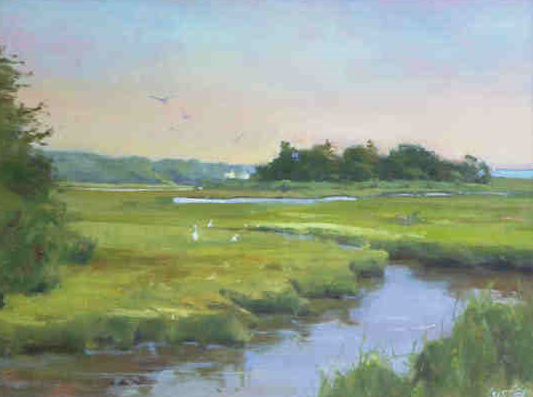
Egret Landing original painting by Barbara Lussier, CT, USA |










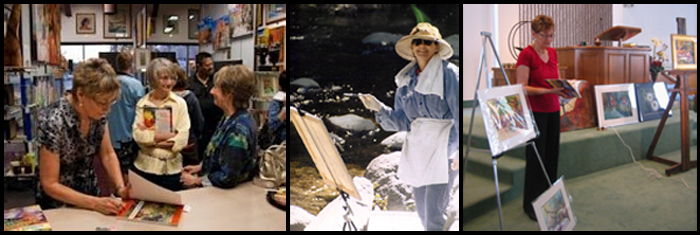



I want to know more about this painting. Oil or acrylic? Did you use a grisalle? Live model or photo? BTW, I really LIKE it!!